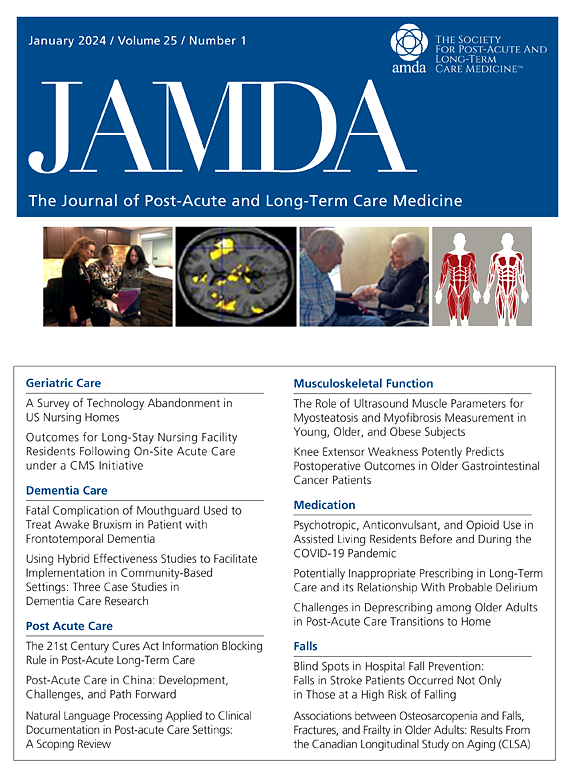长期护理人员配备:与设施特点、住院医师经验和质量措施的关系。
IF 4.2
2区 医学
Q2 GERIATRICS & GERONTOLOGY
Journal of the American Medical Directors Association
Pub Date : 2025-06-03
DOI:10.1016/j.jamda.2025.105686
引用次数: 0
摘要
目标:2022年10月,澳大利亚根据居民的护理需求,为长期护理机构引入了总护理和注册护士(RN)分钟的个人目标。本研究考察了设施特征与护理分钟目标达到程度之间的关系,并确定护理分钟是否与居民的经验和质量措施有关。设计:生态横断面研究,使用2023年1月至3月至2024年1月至3月间5个季度报告期间的公开数据。环境和参与者:澳大利亚共有2292家长期护理机构。方法:使用广义线性混合模型来检验设施特征(所有权类型、规模、位置)与目标护理分钟数(总分钟数和护士分钟数)之间的关系。使用Logistic回归和有序beta回归模型来调查护理时间与住院医师体验和质量措施(压力伤害、限制性做法、计划外体重减轻、跌倒、药物管理)之间的关系。结果:达到或超过总护理分钟目标(≥100%)的机构比例从第一个报告期的41% (n = 938)上升到最近一个报告期的53% (n = 1213)。与政府所有制相比,营利性和非营利性所有制的目标护理分钟达到率较低(比率比,0.76;95% ci, 0.75-0.78;比率比为0.82;95% CI分别为0.80-0.83)。营利性和非营利性的所有权,较大的设施规模,以及农村或社会经济上处于不利地位的位置与较低的目标注册护士分钟的实现百分比相关。护理时间与住院医生的经验或质量指标之间没有统计学上显著的关联。结论和意义:不同的设施特征观察到满足目标护理时间的差异。然而,护理时间和居民的经验或质量措施之间没有联系。进一步的研究应该检查护理时间以及其他影响护理质量的因素,包括员工培训、人员流动、技能组合和护理模式。本文章由计算机程序翻译,如有差异,请以英文原文为准。
Long-Term Care Staffing: Associations with Facility Characteristics, Residents’ Experience, and Quality Measures
Objectives
In October 2022, Australia introduced individual targets for total care and registered nurse (RN) minutes for long-term care facilities based on the assessed care needs of their residents. This study examined associations between facility characteristics and the extent to which care minute targets are met, and determined whether care minutes were associated with residents’ experience and quality measures.
Design
Ecological cross-sectional study using pooled publicly available data from 5 quarterly reporting periods between January-March 2023 and January-March 2024.
Setting and Participants
A total of 2292 long-term care facilities in Australia.
Methods
Generalized linear mixed models were used to examine associations between facility characteristics (ownership type, size, location) and target care minutes met (total and RN minutes). Logistic regression and ordered beta regression models were used to investigate associations between care minutes and residents’ experience and quality measures (pressure injuries, restrictive practices, unplanned weight loss, falls, medication management).
Results
The proportion of facilities meeting or exceeding their total care minutes target (≥100% of target) increased from 41% (n = 938) in the first reporting period to 53% (n = 1213) in the most recent period. Compared with government ownership, for-profit and not-for-profit ownership were associated with lower percentages of target care minutes met (rate ratio, 0.76; 95% CI, 0.75-0.78; and rate ratio, 0.82; 95% CI, 0.80-0.83, respectively). For-profit and not-for-profit ownership, larger facility size, and rural or socioeconomically disadvantaged location were associated with lower percentages of target RN minutes met. No statistically significant associations were identified between care minutes and residents’ experience or quality measures.
Conclusions and Implications
Variation in meeting target care minutes was observed by different facility characteristics. However, no associations between care minutes and residents’ experience or quality measures were observed. Further research should examine care minutes in addition to other factors impacting care quality including staff training, turnover, skills mix, and models of care.
求助全文
通过发布文献求助,成功后即可免费获取论文全文。
去求助
来源期刊
CiteScore
11.10
自引率
6.60%
发文量
472
审稿时长
44 days
期刊介绍:
JAMDA, the official journal of AMDA - The Society for Post-Acute and Long-Term Care Medicine, is a leading peer-reviewed publication that offers practical information and research geared towards healthcare professionals in the post-acute and long-term care fields. It is also a valuable resource for policy-makers, organizational leaders, educators, and advocates.
The journal provides essential information for various healthcare professionals such as medical directors, attending physicians, nurses, consultant pharmacists, geriatric psychiatrists, nurse practitioners, physician assistants, physical and occupational therapists, social workers, and others involved in providing, overseeing, and promoting quality

 求助内容:
求助内容: 应助结果提醒方式:
应助结果提醒方式:


